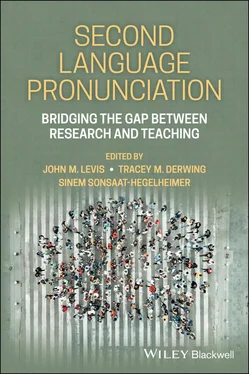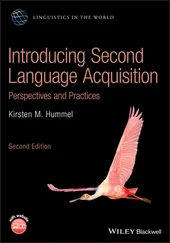Second Language Pronunciation
Здесь есть возможность читать онлайн «Second Language Pronunciation» — ознакомительный отрывок электронной книги совершенно бесплатно, а после прочтения отрывка купить полную версию. В некоторых случаях можно слушать аудио, скачать через торрент в формате fb2 и присутствует краткое содержание. Жанр: unrecognised, на английском языке. Описание произведения, (предисловие) а так же отзывы посетителей доступны на портале библиотеки ЛибКат.
- Название:Second Language Pronunciation
- Автор:
- Жанр:
- Год:неизвестен
- ISBN:нет данных
- Рейтинг книги:5 / 5. Голосов: 1
-
Избранное:Добавить в избранное
- Отзывы:
-
Ваша оценка:
- 100
- 1
- 2
- 3
- 4
- 5
Second Language Pronunciation: краткое содержание, описание и аннотация
Предлагаем к чтению аннотацию, описание, краткое содержание или предисловие (зависит от того, что написал сам автор книги «Second Language Pronunciation»). Если вы не нашли необходимую информацию о книге — напишите в комментариях, мы постараемся отыскать её.
Second Language Pronunciation: Bridging the Gap Between Research and Teaching
Second Language Pronunciation: Bridging the Gap Between Research and Teaching
Second Language Pronunciation — читать онлайн ознакомительный отрывок
Ниже представлен текст книги, разбитый по страницам. Система сохранения места последней прочитанной страницы, позволяет с удобством читать онлайн бесплатно книгу «Second Language Pronunciation», без необходимости каждый раз заново искать на чём Вы остановились. Поставьте закладку, и сможете в любой момент перейти на страницу, на которой закончили чтение.
Интервал:
Закладка:
26 Levis, J. M., & Muller Levis, G. (2018). Teaching high-value pronunciation features: Contrastive stress for intermediate learners. CATESOL Journal, 30(1), 139–160.
27 McGregor, A., Zielinski, B., Meyers, C., & Reed, M. (2016). An exploration of teaching intonation using a TED Talk. In J. Levis, H. Le, I. Lucic, E. Simpson, & S. Vo (Eds.), Proceedings of the 7th Pronunciation in Second Language Learning and Teaching Conference, Dallas, TX, October 2015 (pp. 143–159). Iowa State University.
28 Mora, J. C., & Levkina, M. (2017). Task-based pronunciation teaching and research: Key issues and future directions. Studies in Second Language Acquisition, 39(2), 381–399. doi.org/10.1017/S0272263117000183
29 Munro, M. J., & Derwing, T. M. (1998). The effects of speech rate on the comprehensibility of native and foreign accented speech. Language Learning, 48(3), 159–182.
30 Murphy, J. (2014). Myth: Teacher training programs provide adequate preparation in how to teach pronunciation. In L. Grant (Ed.), Pronunciation myths: Applying second language research to classroom teaching (pp. 188–224). University of Michigan Press.
31 Murphy, J. M., & Baker, A. (2015). History of ESL pronunciation teaching. In M. Reed & J. M. Levis (Eds.), The handbook of English pronunciation (pp. 36–65). Wiley Blackwell.
32 O’Brien, M. G., Derwing, T. M., Cucchiarini, C., Hardison, D. M., Mixdorff, H., Thomson, R. I., Levis, J., Strik, H., Foote, J., & Levis, G. M. (2018). Directions for the future of technology in pronunciation research and teaching. Journal of Second Language Pronunciation, 4(2), 182–207. doi.org/10.1075/jslp.17001.
33 Ruivivar, J., & Collins, L. (2019). Nonnative accent and the perceived grammaticality of spoken grammar forms. Journal of Second Language Pronunciation, 5(2), 269–293. doi.org/10.1075/jslp.17039.rui
34 Tanner, M., & Chugg, A. (2018). Empowering adult ELLS’ fluency and pronunciation skills through readers theater. In J. Levis (Ed.), Proceedings of the 9th Pronunciation in Second Language Learning and Teaching Conference, University of Utah, September 2017 (pp. 185–193). Iowa State University.
35 Thompson, J. (2011). English is stupid. Thompson Language Center.
36 Thomson, R. I. (2018). High variability [pronunciation] training (HVPT): A proven technique about which every language teacher and learner ought to know. Journal of Second Language Pronunciation, 4(2), 208–231. doi.org/10.1075/jslp.17038.tho
37 Thomson, R. I. (2021). English accent coach [online game]. Retrieved from www.englishacccentcoach.com
38 Usher, J. (1995). Teaching pronunciation: Inhalation/exhalation helps students distinguish sounds. Contact, 21, 14–15.
39 Wang, X., & Munro, M. J. (2004). Computer-based training for learning English vowel contrasts. System, 32(4), 539–552. doi.org/10.1016/j.system.2004.09.011
40 Yates, L., & Zielinski, B. (2009). Give it a go! http://www.ameprc.mq.edu.au/__data/assets/pdf_file/0006/276135/interactive_sm.pdf
41 Zielinski, B., & Yates, L. (2014). Myth 2: Pronunciation instruction is not appropriate for beginning-level learners. In L. Grant (Ed.), Pronunciation myths (pp. 56–79). University of Michigan Press.
2 Integrating Pronunciation into Language Instruction
John M. Levis1 and Andrea Echelberger2
1 Iowa State University
2 Literacy Minnesota
“Teacher [only] you understand me” said a visibly frustrated student in a beginning level adult ESL class. Heads nodded in agreement around the room. The student recounted an experience she’d had over the weekend while shopping in the community. She’d asked a native English-speaking store employee a question, one she had practiced numerous times in class the previous week. The employee couldn’t understand her after she had unsuccessfully repeated it several times, and walked away without answering.
This story highlights a frequent occurrence in language classrooms, especially for individuals early in their L2 learning. The teacher knew that the students had pronunciation difficulties, but after several years of working with this population had become accustomed to their pronunciation patterns, making unconscious allowances in listening and largely ignoring pronunciation teaching. This “teacher ear” means that language teachers may have a different interpretation of intelligibility than other people because of exposure to accented speech and comfort with negotiation for meaning (Macdonald, 2002). While it is beneficial for students to have teachers who can understand them, in this case it did not contribute to the improvement of their ability to communicate outside of class. As one teacher in MacDonald’s study observed, “Out in society… not everyone is as patient and understanding” (p. 8). The approach of this teacher to pronunciation instruction parallels the practices of many teachers. When they address pronunciation in the classroom, it is often in an unsystematic and reactive manner (Foote et al., 2016), only addressing errors that “are too prominent to be ignored” (Levis & Grant, 2003, p. 13). This chapter suggests one way to address pronunciation consistently, by integrating pronunciation with the teaching of other skills. We take the perspective of teachers working with immigrant/refugee populations in Adult Basic Education (ABE) programs in the United States.
Critical Issues
Integrating pronunciation into language classes requires an understanding of contextual constraints that influence what can be done by teachers (McGregor & Reed, 2018). This is particularly true for teachers working with adult migrants, immigrants, and refugees in ABE or community-based settings. Due to limited class time, multilevel classes, space constraints, and testing requirements, many teachers in these settings teach pronunciation haphazardly, if they address it at all. The challenges they face make for an interesting opportunity for researchers to explore effective pronunciation teaching; if teachers working in less than ideal situations can effectively integrate pronunciation into regular instruction, so can teachers in a wide variety of teaching and learning contexts.
Community-based language classes have students with a broad range of needs, language and educational backgrounds, and ability levels. For example, a beginning-level adult ESL class may have learners aged 22–82. Within the same classroom there may be learners with advanced degrees who are literate in multiple languages (but not the target language), while others may have only attended a few years of elementary school, with limited literacy in their native language. Some learners may attend classes to develop language skills for employment, others attend to help their children with homework, while still others come to class to stay connected to a community and socialize outside their homes. There are additional logistical challenges that community-based teachers contend with. Classes may take place in shared spaces, requiring teachers to set up and break down their classroom space every day. Classes may have open enrollment, meaning that learners can enter a program anytime or leave anytime because of employment changes, family obligations, health, and so on. It is also common for teaching positions in community-based classes to be part-time and low-paying, with teacher experience and educational requirements varying widely from school to school.
These factors may imply that the stakes for these classes are low, but quite the opposite is true. Several countries that commonly receive immigrants and refugees have national language proficiency requirements built into their naturalization (citizenship acquisition) processes, including Australia, Canada, France, Germany, the Netherlands, and the United States (Berger & Lenz, 2014). Given the demands on adult immigrants’ and refugees’ lives (e.g., working spouses, children, caring for elders), community-based language/citizenship courses, which are generally offered free-of-charge and sometimes include childcare, are frequently the most accessible educational opportunities for this student population. National testing requirements needed for continued funding can add additional pressure on school administrators and teachers. For example, in the United States, adult schools receiving federal education funding must use one of a small handful of tests approved by the National Reporting System (NRS). States are also required to create a state plan for the implementation of content standards aligned with the national Common Core State Standards. A majority of adult education state systems have adopted the College and Career Readiness Standards (CCRS) for Adults (2013), or the English Language Proficiency (ELP) Standards (U.S. Department of Education, 2016), or individual state standards adapted to align to the Common Core, CCRS or ELP Standards. While all sets of national standards for adults specifically address listening and speaking skills, pronunciation features contributing to clear and coherent speech are not specifically referenced. Some states or programs address pronunciation more systematically; adult English language programs in Massachusetts, for example, are required to align their curriculum to the Massachusetts English Language Proficiency Standards for Adult Education (MA ELPS), which directly refers to pronunciation for all levels of speaking and listening standards. However, standards such as the MA ELPS are the exception rather than the norm, and most ABE instruction is literacy-oriented; that is, it emphasizes written language, which is a major, but not the only, challenge faced by learners in ABE, many of whom have been displaced from their countries of origin.
Читать дальшеИнтервал:
Закладка:
Похожие книги на «Second Language Pronunciation»
Представляем Вашему вниманию похожие книги на «Second Language Pronunciation» списком для выбора. Мы отобрали схожую по названию и смыслу литературу в надежде предоставить читателям больше вариантов отыскать новые, интересные, ещё непрочитанные произведения.
Обсуждение, отзывы о книге «Second Language Pronunciation» и просто собственные мнения читателей. Оставьте ваши комментарии, напишите, что Вы думаете о произведении, его смысле или главных героях. Укажите что конкретно понравилось, а что нет, и почему Вы так считаете.












